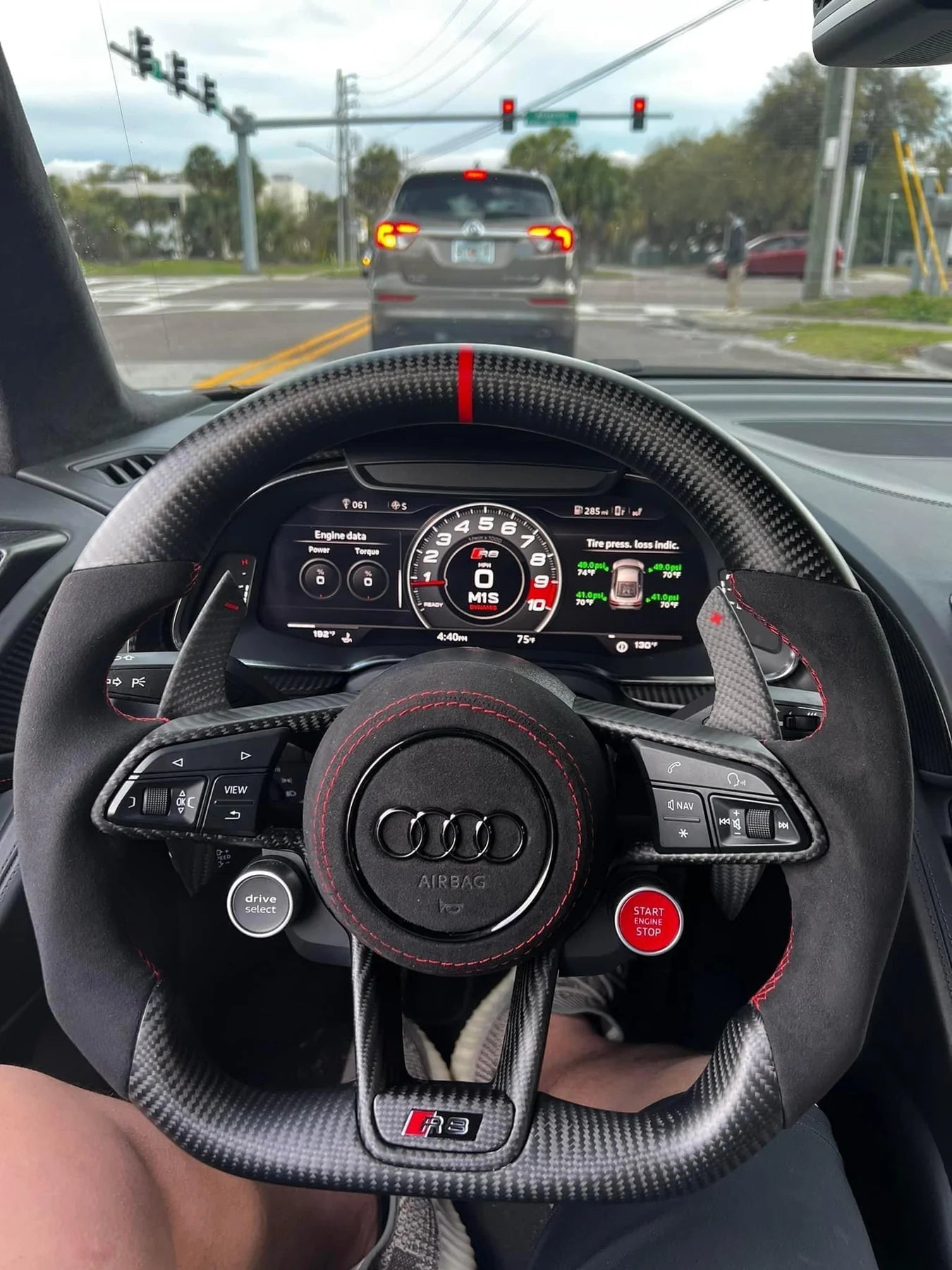Enhancing your vehicle with carbon fiber is an exciting way to elevate its aesthetics and performance. Carbon fiber is a lightweight, high-strength material that adds a touch of luxury and sportiness to any car. This comprehensive guide will walk you through the step-by-step process of enhancing your vehicle with carbon fiber components, covering both exterior and interior upgrades. Whether you own a sports car, a sedan, an SUV, or a truck, this guide will help you achieve a stunning and personalized look for your cherished ride.
Step 1: Research and Identify Compatible Parts Begin by researching reputable manufacturers and vendors that offer high-quality carbon fiber components suitable for your specific vehicle make and model. Look for options like carbon fiber hoods, spoilers, front lips, side skirts, mirror covers, and rear diffusers for exterior upgrades. For the interior, consider door panel trims, center console trims, steering wheel accents, and other interior trim pieces. Ensure that the parts you choose are compatible with your vehicle to ensure a proper fit.
Step 2: Choose High-Quality Carbon Fiber Components Opt for genuine carbon fiber parts to ensure a superior finish and long-lasting durability. Beware of cheap imitations that may not provide the desired results and could potentially damage your vehicle. Investing in high-quality carbon fiber components ensures that your upgrades will not only look great but also withstand the rigors of daily use and exposure to the elements.
Step 3: Prepare Your Vehicle Before starting the installation process, thoroughly clean your vehicle to remove any dirt, debris, or existing wax. Wash the exterior and clean the interior to create a clean surface for the carbon fiber components to adhere to. Additionally, ensure that you have all the necessary tools and materials for the installation process.
Step 4: Exterior Upgrades For exterior enhancements, start with easy-to-install components like carbon fiber mirror covers or emblems. Carefully remove the old parts and replace them with the new carbon fiber pieces, ensuring proper alignment. For more complex upgrades like hoods or spoilers, consider seeking assistance from a professional or an experienced individual to ensure a perfect fit.
Step 5: Interior Enhancements When upgrading your vehicle's interior with carbon fiber, begin with smaller trim pieces like door panel inserts or center console trims. Remove the existing components carefully and replace them with the new carbon fiber parts. Take your time to ensure proper fitment and alignment for a polished look.
Step 6: Maintenance and Care To preserve the beauty and longevity of your carbon fiber enhancements, establish a regular maintenance routine. Clean the carbon fiber components with a mild car wash soap and a soft microfiber cloth regularly. Avoid using harsh chemicals or abrasive materials that could scratch the surface. Applying a dedicated carbon fiber sealant or wax will protect the material from UV rays and keep it looking fresh.
Step 7: Enjoy Your Upgraded Vehicle Once all the carbon fiber enhancements are installed and well-maintained, take pride in your upgraded vehicle's enhanced appearance and performance. Carbon fiber's lightweight properties and stylish appeal will undoubtedly make your ride stand out on the road.
Conclusion: Enhancing your vehicle with carbon fiber is an exciting and rewarding process that can transform its look and performance. By following this complete guide, you can confidently install high-quality carbon fiber components, both inside and outside your vehicle, ensuring a stylish and personalized driving experience. Remember to research compatible parts, choose genuine carbon fiber components, perform regular maintenance, and enjoy the head-turning results of your upgraded vehicle.
Carbon Fiber Vs. Traditional Materials
Carbon fiber is a material that is made by combining carbon fibers with resin. The carbon fibers are long, thin strands that are very strong and lightweight. The resin is a material that holds the carbon fibers together.
Carbon fiber is often used in place of traditional materials, such as steel and aluminum because it is stronger, lighter, and more durable. Carbon fiber is also more resistant to corrosion and fatigue than traditional materials.
Here is a comparing the properties of carbon fiber to some traditional materials:
|
Property |
Carbon Fiber |
Steel |
Aluminum |
|
Strength |
Strong |
Strong |
Strong |
|
Weight |
Very lightweight |
Heavy |
Lightweight |
|
Durability |
Very durable |
Durable |
Durable |
|
Corrosion resistance |
Very resistant |
Resistant |
Not resistant |
|
Fatigue resistance |
Very resistant |
Not resistant |
Not resistant |
How Long Does Carbon Fiber Last On a Car?
The lifespan of carbon fiber components on a car can vary depending on several factors, making it difficult to provide an exact number of years. However, with proper care, Carbon fiber can last between 15 and 50 years, depending on the quality of the material and how well it is cared for.
Here are some factors that can affect the lifespan of carbon fiber parts:
- The quality of the carbon fiber: High-quality carbon fiber will last longer than low-quality carbon fiber.
- The manufacturing process: How the carbon fiber is manufactured can affect its lifespan.
- The environment: Carbon fiber parts exposed to harsh environments, such as UV radiation and extreme temperatures, will not last as long as those not exposed to these environments.
- The maintenance: Carbon fiber parts that are not properly maintained will not last as long as regularly cleaned and waxed parts.

How To Maintain Your Carbon Fiber
- Proper Cleaning: Regularly clean carbon fiber parts using a mild soap or specialized carbon fiber cleaner. Avoid abrasive materials or harsh chemicals that can damage the surface. Gently wipe the parts clean and dry them thoroughly to prevent moisture-related issues.
- Protective Coatings: Apply a protective coating specifically designed for carbon fiber to provide additional protection against UV radiation, chemicals, and environmental elements. This helps prevent fading, discoloration, and potential damage.
- Avoid Excessive Stress: Be mindful of driving conditions and avoid situations that subject carbon fiber parts to excessive stress or impact. Avoid high curbs, speed bumps, and rough roads whenever possible to minimize the risk of damage.
- Temperature Considerations: Extreme heat or cold can affect carbon fiber. Avoid prolonged exposure to extreme temperatures and consider parking the car in shaded or temperature-controlled areas when possible.
- Regular Inspections: Periodically inspect carbon fiber parts for any signs of damage, cracks, or wear. Promptly address any issues to prevent further damage or potential failure.
- Avoid Chemical Exposure: Limit exposure to harsh chemicals, solvents, or petroleum-based products that can degrade or weaken carbon fiber. If cleaning agents are necessary, ensure they are safe for use on carbon fiber and follow the manufacturer's recommendations.
- Proper Installation: Ensure that carbon fiber parts are installed correctly by following manufacturer instructions or consulting with professionals who have experience with carbon fiber components. Improper installation can lead to premature wear or damage.
-
Storage and Transportation: When storing or transporting spare carbon fiber parts, protect them from impacts, extreme temperatures, and excessive moisture. Use appropriate packaging or protective covers to prevent any potential damage.




Leave a comment
This site is protected by hCaptcha and the hCaptcha Privacy Policy and Terms of Service apply.